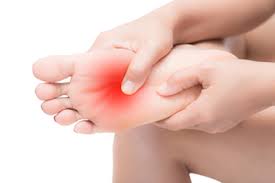
Plantar fasciitis is one of the most common causes of heel pain. For some, it is a mere annoyance that can be easily ignored. For others, it can be a debilitating pain. The good news, though, is that most people find relief with conservative therapies. And, if you know the risk factors to look for, it can be prevented completely!

So, What Is The Plantar Fascia?
The plantar fascia is a band of connective tissue that runs along the bottom of the foot from the heel to the base of the toes. It is very thick centrally near the heel and divides into 5 smaller, thinner bands where it attaches to the toes. Because it is a thick tissue with very little flexibility, it stabilizes the arch of the foot and acts like a tension bridge providing shock absorption for normal daily activities. It also protects delicate underlying nerves and vessels and functions as an attachment site for several small muscles.
With overuse and over-stretching, this band of fascia can develop micro-tears and collagen degeneration. When this degeneration progresses faster than the body’s ability to repair it, we call this plantar fasciitis. Originally, plantar fasciitis was thought to be an inflammatory condition, hence the “itis” term. Research over the years, however, has taught us that while there is some inflammation involved, it is primarily a degenerative condition. Scientists are now using the more appropriate terms of plantar faciosis or tendinosis, but these are not as widely recognized.

How Do I Know If I Have Plantar Fasciitis?
Pain in the arch or heel of the foot with your first steps in the morning is the most common sign of plantar fasciitis. This pain usually decreases gradually through the course of the day, enabling us to ignore the issue. However it often comes back with a vengeance each morning. Others may experience pain or stiffness after standing for long periods. Walking short distances may lessen the pain, but long distances may aggravate it.
While there are not usually outwardly visible signs of injury, some experience swelling of the heel. Plantar fasciitis is diagnosed based on your medical history and a physical exam. Imaging is not commonly used for diagnosis, however your physician may order an x-ray or MRI to rule out other conditions.
In addition to pain in the foot, many people with plantar fasciitis also experience pain in the calf, ankle, and lower back. No, plantar fasciitis does not directly cause these pains. However, if the injuries to your plantar fascia are shifting the way you stand or walk, this can contribute to back pain or tighten your calf muscles. Vice versa, if you have tight calves or back pain that shifts the way you walk, that can result in plantar fascia issues.

Who Is At Risk Of Developing Plantar Fasciitis?
There are many risk factors that can contribute to plantar fascia issues:
- Age. Plantar fasciitis is most common between the ages of 40-60.
- Standing for long hours. Factory workers, teachers, and retail associates who spend most of their day walking or standing on hard surfaces can damage the plantar fascia. Females who stand for long hours in high heels are especially prone.
- Obesity. Excess weight, especially sudden weight gain as in pregnancy, places increased pressure on the foot often resulting in the micro tears that lead to plantar fasciitis. In 2007, one study found that we are 1.7 times more likely to suffer from chronic heel pain if we have a Body Mass Index greater than 25.
- Exercise. Exercise can be vital to healing plantar fasciitis, however certain activities can place a lot of stress on the heel. Long distance runners and ballet dancers can see increased prevalence.
- Foot mechanics. Flat feet, high arch, or an abnormal gait pattern can affect the weight distribution and put stress on the plantar fascia.
What About Heel Spurs?
Contrary to popular belief, there is no scientific evidence that heel spurs cause plantar fasciitis. Heel spurs are calcium deposits that cause a bony protrusion on the bottom of the heel. They are their own separate condition. They do, however, often occur in people who have had plantar fasciitis for a period of time.

What Can I Do About Plantar Fasciitis?
For starters, prevention is key! If your daily life requires long periods of standing, invest in shoes that fit properly and support your feet. Find a local shoe store that offers old-fashioned service like Fleet Feet Hendersonville. It is important to properly measure not only the length of your foot, but also the width and arch. Custom orthotics are also a good option for jobs that require specific footwear
For those that wear heels to work, keep a pair of supportive sneakers nearby for the commute or lunch breaks. Also, remember that shoes can wear out! It is important to replace your footwear on a regular basis.
Gently stretching the bottoms of your feet before exercise or activity can help “warm up” the plantar fascia and the muscles that surround it, so your entire foot is more flexible and therefore less prone to injury and pain. Plus, stretching improves circulation which helps the area heal.
Change up your exercise routine. Long distance running can be a trigger for many people. Try incorporating lower impact activities like swimming or cycling into your routine to give your plantar fascia a little break.
Start a weight loss program. Excess weight can place a lot of pressure on the plantar fascia. Losing weight is not exactly an easy task, but even a small amount can improve your plantar fasciitis symptoms.
Schedule an evaluation at the first signs of pain. At Champion Wellness, we can provide a targeted, conservative approach to healing your pain and getting you back to the activities you enjoy. Whether that plan involves low impact exercise for weight loss, or rehabilitation post-injury, we have you covered.
Heather Champion
Contact Me


